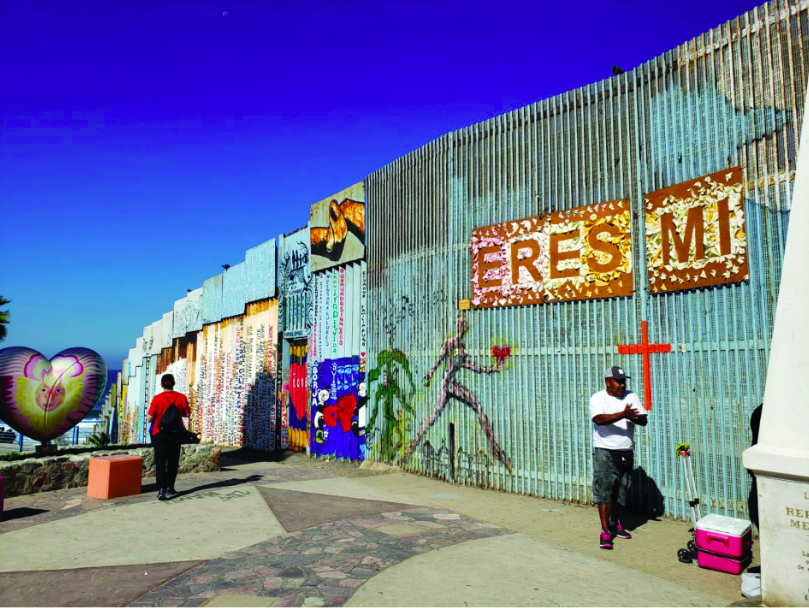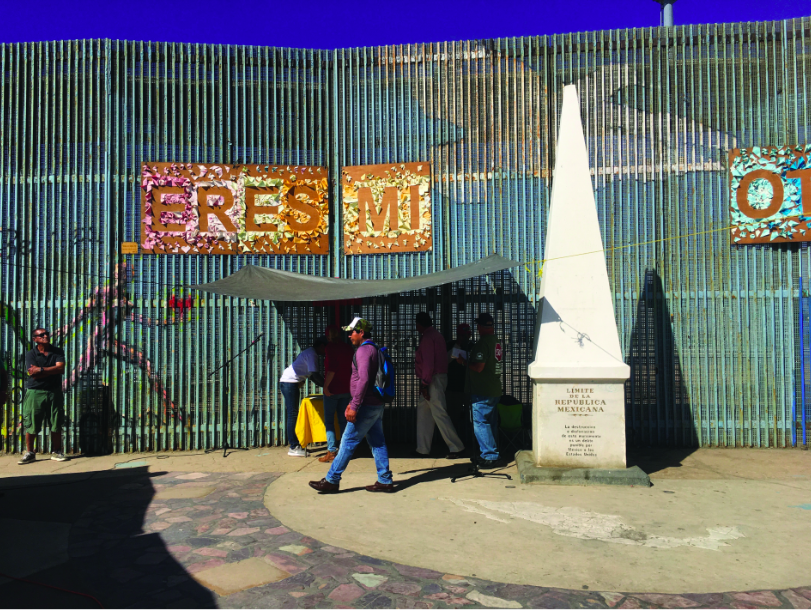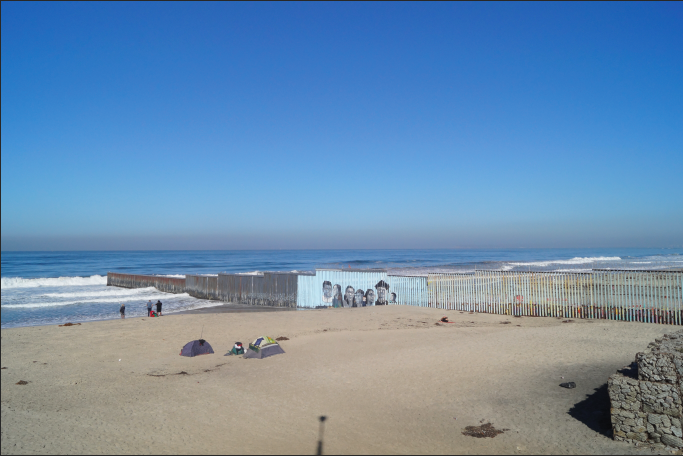A Nation of Immigration
November 8, 2019
Recently, immigration has become a very hot topic in the United States; individuals, regardless of party affiliation, all have different perspectives on how our borders (specifically with Mexico) should be regulated and whether or not these ‘regulations’ should be reduced or bolstered. Republicans have pushed for a zero-tolerance approach and support concepts such as the ‘SAVE (Systematic Alien Verification for Entitlements) Program’ that help agencies determine the immigration status of applicants. Democrats have also argued for border regulations, but have exceptions when it comes to immigrants in poor and unsafe conditions (or are already undocumented in the United States); unlike the most Republicans, Democrats support giving citizenship to undocumented immigrants brought to the United States as children through the Development, Relief, and Education for Alien Minors Act (DREAM). This year, Blake elected to allow students to travel to the California-Mexico border on a trip over M.E.A week. Students got to interact with border patrol agents and citizens to see their similar and differing perspectives as well as what the actual situation is like at the border. Sarah Yousha ‘20 went on the border trip and, when asked about what she learned to talk to border agents, said “heir perspective is…‘we’re just abiding by the law, what we do isn’t necessarily bad or good’… they don’t make the policies they just have to, like, follow them… the main part of their job is making sure all of the children are safe and, like, a lot of them get super dehydrated or they’ve found people passed out because a lot of them [immigrants] are trying to escape something worse in Mexico… their job hasn’t really changed as the administration has changed, and they try to put their political beliefs aside when they do their job”. Border restrictions are something that every nation, regardless of location, faces and, in the United States, both parties have equally respectable perspectives on the topic.

Boosting Border Security will Maximize Safety
Encouraging Legal Immigration is Important
Among the most contested issues in the upcoming 2020 election is one that has been discussed for decades and lies at the heart of American domestic policy. I’m talking, of course, about immigration. In the context of today’s political climate, candidates are eager to get their positions out there and to form a unique opinion. Trump wants to build a wall, and certain democratic candidates advocate for asylum for any current illegal immigrant. Immigration policy should not be a partisan issue, but should instead be focused on how to maximize the benefits for the most people and more importantly minimize the terrible conditions that so many face on and across the border today. For this reason, the United States should take measures to increase border security to limit illegal crossings while also increasing visa caps (the amount of visas given out per year) and reforming the broken green card system to open up flows of legal immigrants.
There is an important distinction to be made when discussing the idea of increasing funding for border security, as it doesn’t always include building a wall and separating families. Funding for border security should instead go towards better training for border patrol officers so they are better equipped to rescue and protect illegal migrants as well as stationing more personal and establishing new infrastructure on the weakest parts of the border. Doing so will help stop illegal immigration before it even happens, rather than hunting down and deporting immigrants that are already here. Less illegal immigration means fewer asylum seekers and thus less structural violence.
Although we should take steps to limit illegal immigration, that doesn’t mean we should work to limit immigration as a whole. Immigrants are a force for good within our economy and that must be supported. That is why the US has visa programs such as H-2A and H-2B that give migrants opportunities to work legally. And, with proper reform to the green-card system, we will not only allow immigrants to move to the US to help our stagnating economy, but limit the need for attempted legal immigration, thus also reducing crime, suffering, and hiding.

Failure to Ease Asylum Policies Worsens Illegal Border Crossings
Restrictions cause danger
In the past 10 years, the number of people seeking asylum in the United States has skyrocketed— from 5,000 people in 2008 to more than 97,000 in 2018, a 2000% increase according to Time. Deteriorating conditions in many countries around the world has led to this dramatic increase. With deteriorating conditions comes desperation to reach the life that many migrants feel is their only way to safety.
The United States has a responsibility to update and maintain its process for migrants seeking asylum, as well as ease restrictions on granting asylum. Failure to reevaluate this process as well as existing limits will drastically increase the number of people willing to cross illegally and the United States, endangering their lives after all but being denied their universal human right to petition for asylum.
Border agents at the San Diego border estimate that they apprehend over 160 people every day illegally crossing and the United States—only in San Diego county. Desperation to enter the United States, both legally and illegally, is high as people search for opportunities, refuge, and resources.
What currently exists is a broken system of asylum application with rules that change daily. The United Nations Declaration of Human Rights grants every person the right to apply for asylum from a country when they are facing persecution. A September Supreme Court ruling upheld the Trump Administration’s plan to deny migrants the ability to apply for asylum if they had passed through another country on their way, meaning that migrants must now apply for asylum in Mexico before seeking asylum from the United States.
For those able to apply, the system at the border in Tijuana, Mexico is housed in a single notebook. When they arrive in Tijuana, migrants add their name to the list and are assigned a number. At night, this notebook is returned to U.S. border patrol. Through word of mouth, a fluctuating number of numbers are called each new morning. If asylum seekers are not at the border wall when their number is called, they lose their spot in line. And this appointment is only to begin the asylum process; months of court dates await.
In response to this inefficient system, more and more migrants are risking their lives to cross the border illegally. A journey once undergone primarily by single Mexican men according to BBC, border patrol agents estimate that 50% of those apprehended are family units from Central America.
In response to these new regulations on applying for asylum, illegal immigration to the U.S. has drastically increased. Customs and Border Patrol reports that they apprehended 851,508 people crossing illegally between Southwest ports of entry in the 2019 fiscal year, compared to 396,579 in the 2018 fiscal year.
Crossing illegally is incredibly dangerous. Migrants set out on uncertain terrain on their own, or pay a coyote to shepard them across, become part of an enormous human trafficking industy that exists at the US-Mexico Border. With such limited ability to legally gain access to the country, these illegal and potentially dangerous routes are only increasing in popularity. In 2019 alone, over 340 migrant deaths have reportedly occurred while trying to illegally cross the border. And since 2014, there have been over 2,243 people reported missing while trying to cross.
Maybe half a mile from where the border wall just into the ocean, right behind a block of houses exists an opening in the wall— an open secret between Tijuana residents and U.S. border patrol with the understanding that desperate people will resort to desperate measures, and they would rather it happen there than in the merciless rip tides of the Pacific Ocean. Placing harmful restrictions on asylum seekers will not solve the problem of illegal immigration to the United States. Only through providing a safe, reasonable, and organized policies to those applying for asylum will stop the rapidly increasing illegal flow of people to the United States.

Alethea Paradis • Nov 8, 2019 at 10:42 pm
I’m so impressed with the nuanced analysis of your staff writers. Clearly, your experiential learning through traveling across the border has fostered a uniquely balanced and sophisticated comprehension of the issues. Keep it up! And encourage your classmates to make this an annual experience!